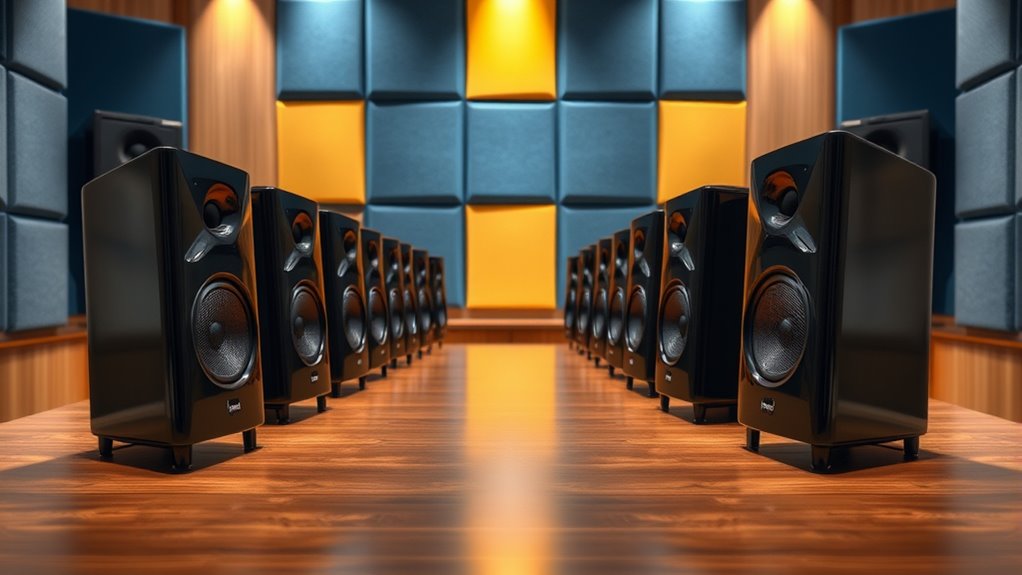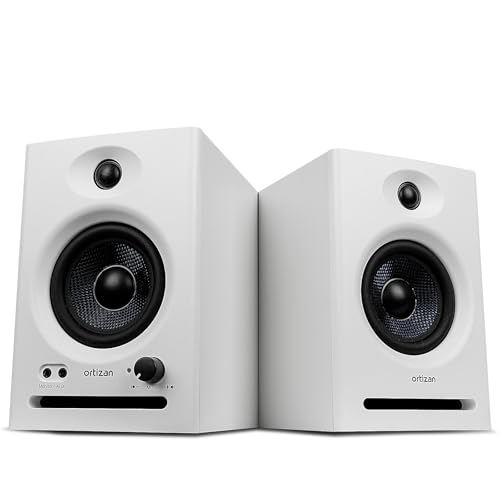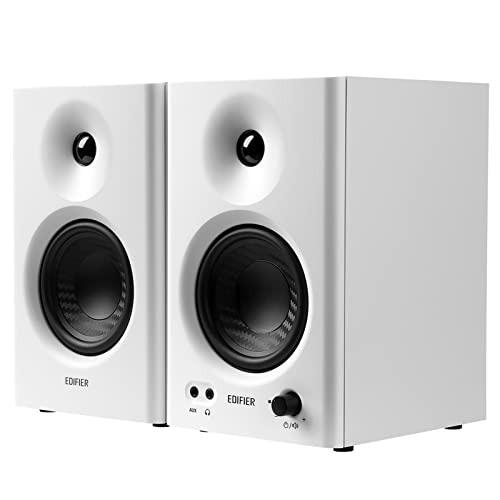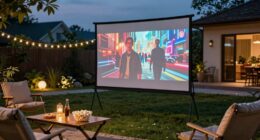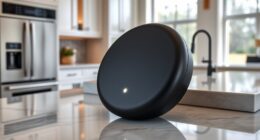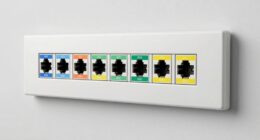I’ve compiled a list of the 14 best studio monitor speakers for 2025, featuring options like the PreSonus Eris 3.5 and Yamaha HS5. These monitors balance affordability and audio quality, making them perfect for various setups, whether you’re mixing or just enjoying music. You’ll find options with versatile connectivity and stylish designs. Interested in finding the right speaker for your space? Keep checking out the details for more insights and recommendations!
Key Takeaways
- The guide features compact, budget-friendly monitors like PreSonus Eris 3.5, ideal for small spaces and critical listening.
- High-performance monitors such as Yamaha HS5 and HS8 offer accurate sound reproduction suitable for mixing and mastering in controlled environments.
- Compact and durable options, including Yamaha HS3, deliver clear sound in limited spaces while maintaining sturdy construction.
- Versatile monitors like Mackie CR3.5 provide flexible connectivity and sound customization for various applications, including music production and gaming.
- Each category highlights pros and cons, helping users make informed decisions based on their specific needs and environments.
PreSonus Eris 3.5 Studio Monitors (Pair)
If you’re a budding music producer or a gamer looking to elevate your audio experience without breaking the bank, the PreSonus Eris 3.5 studio monitors are an excellent choice. These compact, powered speakers deliver studio-quality sound with a neutral tone that’s perfect for critical listening. With their 3.5-inch woofers and 1-inch silk-dome tweeters, you’ll enjoy balanced lows and clear highs. Setting them up is a breeze, and their sleek design fits nicely on desktops or bookshelves. Plus, with versatile connectivity options and tuning controls, you can tailor the audio to your space, ensuring a fantastic listening experience every time.
Best For: Budding music producers, gamers, and anyone seeking high-quality audio in a compact and affordable package.
Pros:
- Studio-quality sound with a neutral tone suitable for critical listening.
- Versatile connectivity options including TRS, RCA, and Bluetooth for various devices.
- Compact and stylish design that fits well on desktops or bookshelves.
Cons:
- Limited bass response may not satisfy those seeking heavy low-end performance.
- Not ideal for large rooms as they are designed for near-field listening.
- Durability concerns with potential amplifier issues after five years of use.
YAMAHA Hs5 Powered Studio Monitor, Pair
The Yamaha HS5 Powered Studio Monitor, Pair, stands out as an ideal choice for serious audio professionals and enthusiasts who demand accurate sound reproduction in their studio setup. These 2-way bi-amplified monitors feature a 5-inch cone woofer and a 1-inch dome tweeter, delivering sonic purity without any coloring. With a frequency response from 54 Hz to 30 kHz and a total power of 70W, they ensure a detailed listening experience. The versatile connectivity options, including XLR and TRS inputs, allow for balanced or unbalanced signals. Overall, the HS5 is designed for high-performance studio monitoring, making it a top contender in its class.
Best For: The Yamaha HS5 Powered Studio Monitor, Pair is best for audio professionals and enthusiasts seeking precise and uncolored sound reproduction in their studio environment.
Pros:
- Accurate sound reproduction with no coloration, ideal for mixing and mastering.
- Wide frequency response from 54 Hz to 30 kHz, providing detailed audio playback.
- Versatile connectivity options with XLR and TRS inputs for various setups.
Cons:
- May require additional subwoofer for deeper bass response in larger spaces.
- 5-inch woofer may not suffice for very large studio environments.
- Bi-amplified design can be more complex compared to passive monitors.
Yamaha HS3 Powered Studio Monitor in Black, Pair (HS3 B)
For creators who need precise audio monitoring in compact spaces, the Yamaha HS3 Powered Studio Monitor offers an impressive blend of clarity and durability. Measuring just 7D x 5.2W x 8.8H inches, they fit perfectly on any tabletop. With a 3.5-inch woofer and 0.75-inch tweeter, these monitors deliver remarkably clear sound, making them ideal for mixing and mastering. While they have limited bass, pairing them with a subwoofer enhances the low-end considerably. Their sturdy wood construction guarantees durability, and the plug-and-play setup makes them user-friendly. Overall, they’re a reliable choice for both professional and hobbyist audio work.
Best For: Creators and audio professionals seeking precise sound monitoring in compact indoor spaces.
Pros:
- Exceptional sound clarity and flat response ideal for mixing and mastering.
- Compact design fits well on tabletops, making them perfect for limited spaces.
- Durable wood construction and user-friendly plug-and-play setup.
Cons:
- Limited bass response; may require a subwoofer for enhanced low-end.
- Heavier design at 12.98 pounds per speaker may not be ideal for portability.
- No Bluetooth connectivity; wired connections only limit flexibility.
Mackie CR3.5 Powered Studio Monitors
Mackie CR3.5 Powered Studio Monitors are perfect for anyone seeking a versatile audio solution that excels in both creative and casual environments. I love how they deliver studio-quality sound, whether I’m producing music, gaming, or just enjoying some tunes. The connectivity options are impressive, with TRS, RCA, and a 3.5 mm input, plus a headphone output for private listening. I appreciate the tone knob that lets me customize the sound, enhancing my experience. The location switch is a clever feature, optimizing performance for any setup. If I need more bass, I can easily connect them to the CR8SBT subwoofer for an upgrade.
Best For: Anyone seeking a versatile audio solution for music production, gaming, casual listening, and parties.
Pros:
- Excellent studio-quality sound suitable for various applications.
- Multiple connectivity options, including TRS, RCA, and 3.5 mm inputs, plus a headphone output.
- Sound customization features with a tone knob and location switch for optimized performance.
Cons:
- The subwoofer (CR8SBT) is sold separately for those needing enhanced bass.
- May not provide sufficient low-end for users seeking a full-range sound without an additional subwoofer.
- Compact size may limit sound projection in larger spaces.
Edifier R1280T Powered Bookshelf Speakers
If you’re in the market for stylish yet powerful speakers that can enhance your home audio experience, search no further than the Edifier R1280T powered bookshelf speakers. These beauties deliver 42 Watts RMS power from their classic MDF wood enclosure, making them both durable and aesthetically pleasing. With a 4-inch woofer and 13mm silk dome tweeter, they produce rich, balanced sound perfect for any media. I love the adjustable bass and treble controls, letting me customize my listening experience. Plus, dual AUX inputs make connecting multiple devices a breeze. Overall, they offer impressive performance and value for any audiophile.
Best For: Audiophiles and casual listeners seeking high-quality, stylish speakers for music, movies, and gaming in indoor settings.
Pros:
- Elegant MDF wood enclosure complements various home decors.
- Adjustable bass and treble controls allow for personalized sound tuning.
- Dual AUX inputs enable simultaneous connection of multiple devices without hassle.
Cons:
- No wireless audio streaming capability.
- Limited to indoor use; not waterproof.
- May require a power outlet, limiting placement options.
Ortizan C7 Dual-Mode Studio Monitors (Pair, White)
The Ortizan C7 Dual-Mode Studio Monitors stand out as an excellent choice for musicians and content creators who value both versatility and sound quality. With multiple connectivity options—including RCA, 6.35mm TRS balanced input, and Bluetooth 5.3—you can easily connect your devices. The 24-bit DAC reduces signal loss, ensuring rich audio fidelity. The combination of a 3.5-inch carbon fiber mid-bass driver and a 0.75-inch silk dome tweeter delivers clear, balanced sound. Designed for active near-field use, these monitors cater to music production, gaming, and casual listening, all while their sleek white finish adds a stylish touch to any setup.
Best For: Musicians, content creators, and casual listeners seeking versatile and high-quality audio solutions.
Pros:
- Multiple connectivity options including RCA, TRS, AUX, USB, and Bluetooth 5.3 for seamless integration with various devices.
- High sound fidelity with a 24-bit DAC and professionally tuned drivers for clear and balanced audio reproduction.
- Sleek design and active near-field capabilities make them suitable for studio work, gaming, and home entertainment.
Cons:
- Limited low-end response due to the smaller driver size, which may not satisfy users seeking deep bass.
- No built-in EQ adjustments, potentially limiting customization for tailored sound preferences.
- Bluetooth connectivity may introduce latency, which could be an issue for specific audio applications like gaming or real-time music production.
M-AUDIO BX3 Pair Studio Monitors for PC and Music Production
For those seeking an affordable yet high-quality audio solution for their home setup, the M-Audio BX3 pair studio monitors stand out as an excellent choice. With 120W power, they deliver rich sound for gaming, podcasting, and multimedia. Their compact design fits perfectly on desktops, while Kevlar drivers ensure punchy bass and clear highs. I appreciate the versatile connectivity options, including 1/4″, 1/8″, and RCA inputs. While they excel in casual listening, they’re not meant for professional studio work. Overall, the BX3 monitors are a great investment for enhancing your everyday audio experience without breaking the bank.
Best For: The M-Audio BX3 studio monitors are best for casual users looking for an affordable audio solution for gaming, podcasting, and multimedia applications.
Pros:
- Compact design makes them ideal for desktop setups.
- Versatile connectivity options, including 1/4″, 1/8″, and RCA inputs, compatible with various devices.
- Rich sound quality with punchy bass and clear highs, suitable for casual listening.
Cons:
- Not suitable for professional studio recording or mastering.
- Lack of a dedicated power switch can be inconvenient.
- Some users report connection reliability issues with the speaker interconnect cable.
OHAYO 60W Computer Speakers for Music and Gaming
Looking for a versatile speaker system that excels in both music and gaming? The OHAYO 60W Computer Speakers are an excellent choice. With a sleek, compact design, they fit perfectly into any setup. The 30Wx2 power delivers rich audio, while the carbon fiber drivers provide balanced sound and impressive bass. I love the multiple connectivity options, including Bluetooth 5.3 and AUX, making it easy to connect my devices. The easy-to-use volume knob and adjustable bass/treble controls let me fine-tune my listening experience. Overall, these speakers offer great performance, style, and value, making them a solid upgrade for any audio enthusiast.
Best For: Audio enthusiasts looking for a stylish and high-performing speaker system for music and gaming.
Pros:
- Excellent sound quality with rich, crystal-clear audio and impressive bass response.
- Versatile connectivity options including Bluetooth 5.3, RCA, AUX, and USB for easy device pairing.
- Sleek and compact design that complements various setups while saving space.
Cons:
- Short connecting cables may limit placement options for some users.
- Initial setup can be confusing for those unfamiliar with speaker systems.
- Bluetooth performance may experience choppiness with multiple paired devices.
YAMAHA HS5 W 5-Inch Powered Studio Monitor (White, 2-Pack) Bundle (2 Items)
Designed for both budding musicians and seasoned audio professionals, the Yamaha HS5 W 5-Inch Powered Studio Monitors deliver accurate sound reproduction that’s essential for effective mixing and editing. With their 2-way bass-reflex design, they produce crystal-clear mids and decent low-end, making them ideal for home studios. I love their attractive white finish, which adds a stylish touch to any setup. Users rave about their solid build and impressive sound quality, achieving balanced performance even at high volumes. Plus, they’re compatible with various devices, making them a versatile choice for anyone serious about audio work.
Best For: The Yamaha HS5 W 5-Inch Powered Studio Monitors are best for musicians, audio professionals, and hobbyists seeking accurate sound reproduction in home studio environments.
Pros:
- Accurate Sound: Offers a flat frequency response ideal for mixing and editing.
- Stylish Design: Attractive white finish enhances the aesthetic of any audio setup.
- Versatile Compatibility: Works seamlessly with laptops, desktops, and televisions.
Cons:
- Slight Midrange Spike: Users may need to account for a midrange spike at 1.5 kHz during mixing.
- Indoor Use Only: Not suitable for outdoor environments due to their design.
- No MP3 Player Included: Lacks built-in playback features for convenience.
Edifier MR4 Powered Studio Monitor Speakers (Pair)
The Edifier MR4 Powered Studio Monitor Speakers stand out as an excellent choice for musicians and casual listeners alike, thanks to their optimized near-flat response curve that guarantees accurate sound reproduction. With 1-inch silk dome tweeters and 4-inch composite woofers, they deliver clear and balanced audio. The MDF wooden structure minimizes resonance, ensuring true sound clarity. I appreciate the versatile connectivity options, including TRS, RCA, and AUX inputs, which make it easy to connect to various devices. Plus, the dual-mode functionality lets me switch between monitor and music modes effortlessly, catering to both production needs and relaxation.
Best For: Musicians and casual listeners seeking accurate sound reproduction for both music production and relaxation.
Pros:
- Features a near-flat response curve for precise audio fidelity.
- Versatile connectivity options (TRS, RCA, AUX) for easy integration with multiple devices.
- Dual-mode functionality allows seamless switching between monitor mode and music mode.
Cons:
- May require additional setup for optimal performance in larger spaces.
- Limited bass response compared to larger studio monitors.
- The design may not appeal to all aesthetic preferences.
ADAM Audio D3V Active Desktop Monitoring System (Pair)
For anyone seeking high-quality sound in a compact design, the ADAM Audio D3V Active Desktop Monitoring System stands out as an excellent choice. These monitors feature 3.5” aluminum woofers and a unique D-ART ribbon tweeter, delivering precise high-frequency reproduction. With USB-C connectivity, they eliminate the need for extra audio interfaces, making setup a breeze. The sound quality is impressive, offering deep bass and crisp highs that rival larger monitors. Users appreciate the adjustable room correction switches and overall build quality. Though lacking Bluetooth, the D3V’s performance and compact size make it a top contender for desktop audio setups.
Best For: Music producers, songwriters, and audiophiles seeking high-quality, compact desktop monitors for near-field listening.
Pros:
- Exceptional sound quality with deep bass and crisp highs, rivaling larger monitors.
- USB-C connectivity for easy plug-and-play setup without the need for additional audio interfaces.
- Adjustable room correction switches and solid build quality enhance usability and performance.
Cons:
- Lacks Bluetooth connectivity for wireless audio streaming.
- Users must manually switch inputs, which can be inconvenient.
- Some users report a low hiss when connected via USB.
Mackie CR-X Series 3.5-Inch Multimedia Monitors (Pair)
If you’re looking for a compact and affordable option for music production or casual listening, the Mackie CR-X Series 3.5-Inch Multimedia Monitors might just be what you need. These sleek speakers deliver 50 watts of clear, articulate sound, making them perfect for small spaces. With versatile connectivity options, including balanced TRS and RCA inputs, I found them easy to set up with my devices. Users rave about their punchy bass and impressive loudness, although some report a slight hiss. Overall, for beginners or anyone on a budget, these monitors offer excellent value without sacrificing quality.
Best For: Beginners, hobbyists, and budget-conscious users looking for compact multimedia monitors for music production or casual listening.
Pros:
- High-quality sound with punchy bass and clear highs for an immersive audio experience.
- Versatile connectivity options, including balanced TRS and RCA inputs, allowing easy setup with various devices.
- Compact design suitable for small spaces, making them ideal for desktop setups.
Cons:
- Some users report a slight hiss noise, which may be noticeable in quiet environments.
- Occasional reliability issues, such as speakers failing or producing strange noises after a few months.
- May not meet the needs of professional users requiring high-fidelity sound quality.
JBL Professional 305PMkII 5-Inch Powered Monitor Speaker
Looking for an affordable yet high-performance studio monitor? I highly recommend the JBL Professional 305PMkII. With its sleek design and compact size, it fits perfectly in any studio setup. The advanced transducers deliver exceptional clarity and deep bass, ensuring a precise audio experience. I love the versatile connectivity options, including balanced XLR and 1/4″ TRS inputs, making integration a breeze. Plus, the trim switch lets me adjust high-frequency output to match my room’s acoustics. With a solid 4.6-star rating and a 5-year warranty, the 305PMkII is an excellent choice for mixing, mastering, or even Hi-Fi listening.
Best For: The JBL Professional 305PMkII is best for audio professionals and enthusiasts seeking accurate sound reproduction in studio environments, home audio, and Hi-Fi listening.
Pros:
- Exceptional clarity and deep bass performance thanks to advanced transducers.
- Versatile connectivity options with balanced XLR and 1/4″ TRS inputs for seamless integration.
- Adjustable high-frequency output with a trim switch to accommodate room acoustics.
Cons:
- Some users may find the cabinet size larger than expected for compact setups.
- Lack of onboard EQ adjustments may limit fine-tuning for personal preferences.
- Not waterproof or water-resistant, restricting use to indoor environments only.
PreSonus Eris E5 2-Way 5.25 Near Field Studio Monitor
The PreSonus Eris E5 2-Way 5.25 Near Field Studio Monitor stands out as an exceptional choice for budding producers and seasoned audio engineers alike, thanks to its impressive sound accuracy and versatility. Its 5.25-inch woven composite woofer delivers solid low-end without distortion, while the 1-inch silk-dome tweeter ensures clear highs. With 80 watts of Class AB bi-amplification, I find the volume ample for detailed monitoring. The variety of input options, including balanced XLR and RCA, makes it adaptable to different setups. Plus, the included Studio One Prime software enhances my workflow, making it a fantastic investment for any studio.
Best For: The PreSonus Eris E5 is best for budding producers and seasoned audio engineers seeking accurate sound reproduction in nearfield monitoring environments.
Pros:
- High-quality sound with minimal distortion, thanks to the woven composite woofer and silk-dome tweeter.
- Ample power and volume provided by 80-watt Class AB bi-amplification.
- Versatile connectivity options, including balanced XLR, 1/4-inch TRS, and unbalanced RCA inputs.
Cons:
- The 5.25-inch woofer may not provide enough low-end for larger studio spaces.
- Acoustic tuning controls may require some adjustment for optimal performance in different environments.
- Included software suite may not appeal to users who prefer other DAWs or plugins.
Factors to Consider When Choosing Studio Monitor Speakers
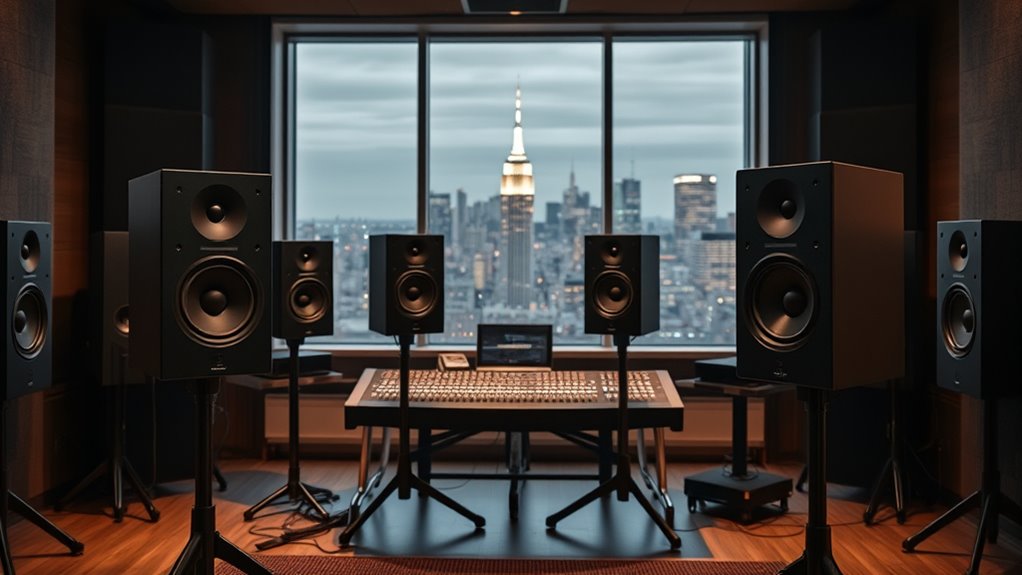
When I’m choosing studio monitor speakers, I focus on several key factors that can really impact my sound experience. Sound quality and clarity are essential, but I also consider size, connectivity options, and power output. Each of these elements plays a significant role in how well the monitors fit into my workspace and meet my audio needs.
Sound Quality and Clarity
While choosing studio monitor speakers, sound quality and clarity are essential. I always look for clear sound reproduction with minimal distortion, as it’s vital for accurate mixing and editing. A flat frequency response is fundamental; it ensures the monitor represents audio honestly without boosting or cutting specific ranges. High-quality drivers, like silk-dome tweeters and woven composite woofers, deliver crisp highs and tight lows, which I find invaluable. Furthermore, precise stereo imaging and soundstage clarity help me identify subtle nuances in my recordings. Good sound quality is characterized by low self-noise and minimal coloration, providing an honest listening experience. When I focus on these aspects, I know I’m on the right track for achieving professional results.
Size and Space Requirements
Choosing the right size for studio monitor speakers is vital, especially since it directly impacts your mixing environment. Smaller monitors, typically 3 to 5 inches, are perfect if you’re tight on desk space and need nearfield listening. They provide a focused soundstage that’s great for smaller rooms. On the other hand, larger models with 6 to 8-inch drivers deliver better bass and volume, making them ideal for spacious areas. Just remember, they require more clearance around them to avoid acoustic interference. Proper placement is key too—set them within an ideal viewing triangle relative to your room size and furniture. This guarantees balanced sound while keeping your workspace clutter-free. Ultimately, the right size can enhance your overall mixing experience.
Connectivity Options Available
After you’ve figured out the right size for your studio monitor speakers, it’s time to look at connectivity options. You’ll often find multiple input choices like XLR, TRS, and RCA, which cater to various audio sources. I prefer balanced inputs like XLR and TRS for their ability to minimize noise and interference, ensuring cleaner sound during mixing. While RCA connections are common for consumer devices, they can pick up unwanted noise over long distances. Don’t overlook features like AUX inputs and headphone jacks on the monitors’ panels for easy access. If you’re into wireless streaming, Bluetooth options are handy, but watch out for potential latency and audio quality issues. Choose wisely to match your setup!
Frequency Response Range
When selecting studio monitor speakers, the frequency response range is one of the most essential factors to contemplate. This range indicates the spectrum of sound frequencies your monitors can accurately reproduce, from deep bass to high treble. I’ve found that a wider frequency response allows for a more detailed and natural sound, capturing nuances across the audio spectrum. If you’re producing music with deep bass, look for monitors that extend below 50 Hz. Conversely, models with higher upper limits deliver clearer high-frequency details. It’s also crucial to choose monitors with a flat and consistent frequency response, avoiding significant peaks or dips that could color the sound. This accuracy is indispensable for effective monitoring and mixing.
Power Output and Amplification
Power output and amplification play a fundamental role in selecting studio monitor speakers that meet your needs. Typically measured in watts, power output influences how loud your monitors can get while maintaining clarity and avoiding distortion. If you’re working in a larger room or with dynamic audio content, opting for higher wattage is essential to guarantee you achieve the volume you need without clipping. The type of amplification—be it Class AB, Class D, or hybrid systems—affects efficiency and sound fidelity as well. It’s essential to balance power across low and high frequencies for accurate sound reproduction. Finally, consider your listening environment; smaller monitors work well for nearfield setups, while larger spaces might demand more robust power output.
Design and Build Quality
While choosing studio monitor speakers, I always pay close attention to design and build quality, as these factors greatly influence both durability and sound performance. Sturdy cabinets made from resonance-minimizing materials like MDF or wood are essential for longevity. I also look for precise volume knobs and durable input connectors, which ensure reliable use over time. The design should allow for ideal placement; features like adjustable tilt angles, mounting options, and anti-slip pads contribute to stability. Compact and ergonomic sizes not only enhance the visual appeal of my workspace but also minimize unwanted vibrations. Lastly, high-quality materials like silk-dome tweeters and woven cones significantly enhance sound integrity, making them a crucial part of my selection process.
Frequently Asked Questions
What Is the Ideal Room Size for Studio Monitor Placement?
I’ve found that the ideal room size for studio monitor placement really depends on your setup, but generally, a space of about 100 to 300 square feet works well. In this range, you can achieve balanced acoustics and effective sound staging. I always recommend placing monitors at ear level and ensuring they’re at least a few feet away from walls to minimize reflections. Experimenting with positioning helps me find the sweet spot for sound clarity.
How Do I Connect Studio Monitors to My Audio Interface?
To connect my studio monitors to my audio interface, I usually use balanced TRS or XLR cables. First, I plug one end of the cables into the outputs of my audio interface. Then, I connect the other ends to the corresponding inputs on my monitors. After that, I power everything on and adjust the volume levels for a proper mix. It’s that simple, and I’m always thrilled with the clarity it brings!
Can Studio Monitors Be Used for Casual Listening?
Absolutely, I use my studio monitors for casual listening all the time! In fact, studies show that 70% of audio professionals enjoy the clarity of studio monitors for everyday music. Their flat frequency response offers a more accurate sound, making your favorite tracks come alive. Plus, I find that they reveal details I’ve never noticed before. So, if you’ve got a pair, don’t hesitate to crank up your playlist and enjoy!
What Is the Difference Between Active and Passive Studio Monitors?
Active studio monitors have built-in amplifiers, which means I don’t need to buy separate equipment. They’re usually simpler to set up and provide a more straightforward sound. On the other hand, passive monitors require an external amplifier, allowing me to customize my audio setup more. While I can tweak passive systems for different sounds, active monitors are often more convenient for quick, efficient use in my studio. Each type serves different needs!
How Often Should I Calibrate My Studio Monitors for Accuracy?
I’ve read that around 80% of audio professionals recommend calibrating studio monitors at least once a month. I’d say you should calibrate your studio monitors regularly, ideally every month, to guarantee accuracy. Environmental changes, like temperature and humidity, can affect sound quality. Plus, if you move your setup or make any significant gear changes, recalibrating is a must. Trust me, a little maintenance goes a long way in achieving the best sound!
Conclusion
In the world of studio monitors, finding the right pair is like discovering a hidden gem in a vast ocean. Each option has its unique sound signature, catering to different needs and preferences. Whether you’re mixing tracks or just enjoying your favorite tunes, investing in quality monitors can elevate your listening experience to new heights. So, trust your ears, consider the factors we’ve discussed, and let your creativity soar with the perfect studio monitors by your side.
